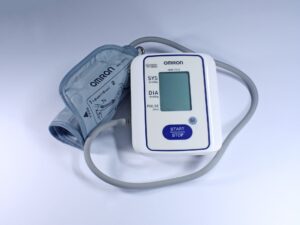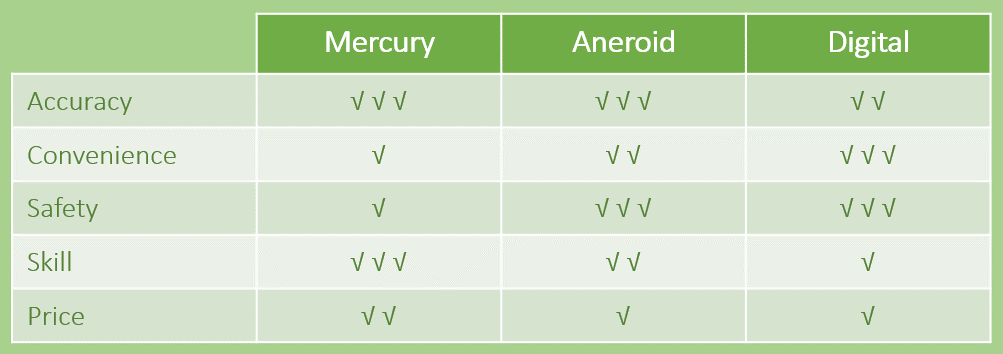Page Contents
We have discussed hypertension in our previous blog article and shared the importance of maintaining a stable blood pressure (BP), complications of having hypertension, and so forth.
In this article, we will talk about how to correctly perform BP self-monitoring.
Types of blood pressure machines
BP machines also known as sphygmomanometer. It is commonly seen in hospital, clinic, health screening kiosk, pharmacy, etc. There are 3 common types of machines, all have their own advantages and disadvantages.
- Mercury sphygmomanometer (arm-cuff)
- Aneroid sphygmomanometer (arm-cuff)
- Digital sphygmomanometer (arm- or wrist-cuff)





Which one is better?
Comparing the 3 sphygmomanometers, we can look at them in a few aspects as below (Figure 1):
- Accuracy: Even though the digital version has gained much popularity, mercury sphygmomanometer is still the gold standard and used in many healthcare institutions.
- Convenience: Aneroid and digital sphygmomanometers are more portable and lightweight, hence they are easier to use. Digital sphygmomanometer gives fast and direct reading without the need to read from the scale.
- Safety: As mercury sphygmomanometer uses mercury to measure the BP, any accident or breakage may pose a safety risk, only trained personnel is allowed to operate.
- Skill: Operating and reading a mercury sphygmomanometer requires training, hence it is not as user-friendly as its counterparts. As such, digital sphygmomanometer requires zero skill to operate.
- Price: Although sphygmomanometer is not an expensive device nowadays, the mercury sphygmomanometer is still relatively expensive compared to the other two.


For the home-use self-monitoring purpose, digital sphygmomanometer is recommended because it is easy to operate and you can read the measurement directly from the screen. You can plug in to a wall socket or use alkaline batteries without the hassle to pump and control the bulb.
Wrist-cuff digital sphygmomanometer is found to be less accurate as compared to arm-cuff model. The American Heart Association (AHA) advises against the use of wrist-cuff BP monitoring. AHA suggested that arm-cuff used on the upper arm are generally more accurate.
Similarly, there are many wearables or smart watches nowadays claiming to have BP-reading function. You should note that the readings are just indicative, it is never accurate as compared to proper BP machines.
Before measuring blood pressure
Regardless of which BP machines you use, a few advices to ensure you get consistent readings.
- Time: Take BP measurement at around the same time daily. Usually morning and evening tend to have lower readings as compared to the afternoon.
- Posture: Standing, sitting, and lying down will give different readings on your BP.
- Exercise: Taking measurement immediately after exercise or sitting down will show higher reading. Recommended to rest a while before measure.
- Habits: Consuming alcohol, caffeinated beverages or nicotine use (smoking) can cause palpitations and affect BP readings, leading to inaccuracy.
- Full bladder: If you have a full bladder during measurement, you can get an error in systolic BP.
- Restlessness / anxiety: Feeling restlessness or anxiety can also lead to higher BP reading. This is a very common effect of white-coat syndrome.
- BP machine: It is also important to use the same BP machine every time so that your readings will not get too far off.
- Same arm: Performing BP measurement on same arm can reduce the variations.
- Lean against the back of the chair and sit upright.
- Place your feet flat on the floor and rest your arm on a tabletop even with your heart.
- Stretch out your arm with palm facing upward.
- Wear a short-sleeved shirt so that the arm-cuff can be placed more easily around your upper arm.
- Position the arm-cuff on your bare upper arm one inch above the bend of your elbow.
- Relax in a chair for at least five minutes before taking measurement.
How to interpret the BP readings?
You will always get a pair of number from BP machine, the systolic and diastolic pressures. Both numbers are essential for diagnosing hypertension. Doctors generally will read the top number (systolic pressure) as the indicator.
Other than the few factors mentioned above (time, posture, exercise, habits, etc.), there are also some factors that can affect the BP readings. For example, your BP tends to get higher as you age. The adult’s standard of 120/80 is no longer applicable to an elderly person. If you are taking long-term medications, your BP may also deviate from a healthy adult of your same age.
Conclusion
It is helpful to get a digital sphygmomanometer for your home and start keeping daily record. Performing BP monitoring daily can give you an idea of your blood pressure status. Should you identify any abnormality trend over a period of few days, you should bring your record to a doctor and seek consultation.

